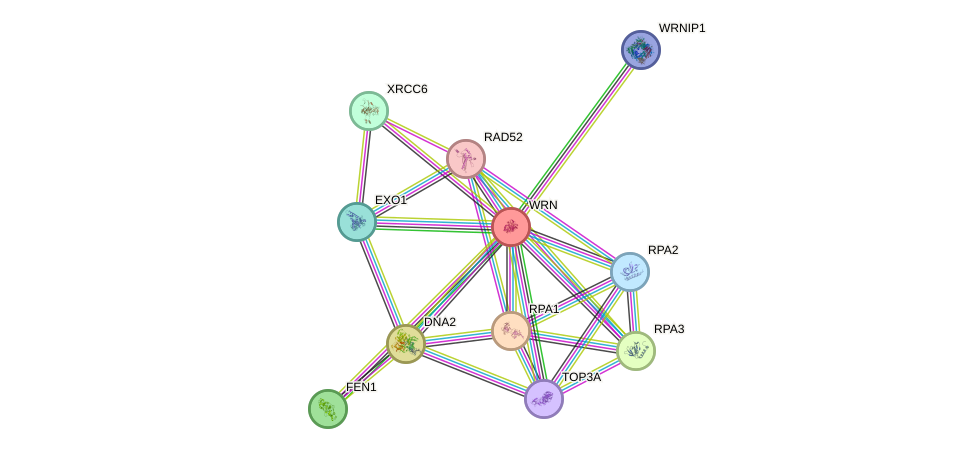GenAge entry for WRN (Homo sapiens)
Entry selected based on evidence directly linking the gene product to ageing in humans
Gene name (HAGRID: 13)
- HGNC symbol
- WRN
- Aliases
- RECQL2; RECQ3
- Common name
- Werner syndrome, RecQ helicase-like
Potential relevance to the human ageing process
- Main reason for selection
- Entry selected based on evidence directly linking the gene product to ageing in humans
- Description
Werner syndrome (WS), caused by mutations in WRN, is probably the most dramatic segmental progeroid syndrome. Although there are differences between the pathobiology of normal ageing and the phenotype of WS, the age-related changes of WS patients are remarkably similar to those found during normal ageing, only they occur at earlier ages [56]. WRN is one of the strongest candidates for genes influencing human ageing.
WRN-deficient mice display reduced embryonic survival, increased tumour formation, and their fibroblasts show features similar to those found in fibroblasts derived from WS patients such as a premature loss of proliferative capacity, though their ageing process appears unaltered [730]. In late-generation mice without TERC, and hence with short telomeres, WRN mutations result in a phenotype resembling accelerated ageing somewhat reminiscent from WS [1069].
WRN is a helicase and exonuclease involved in many DNA repair and processing pathways [1265]. Genetic variation studies in breast cancer patients, showed that WRN might have an important tumorigenic role [3648]. Human WRN-null mesenchymal stem cells show several features associated with accelerated aging [4332]. These include increased senescence associated markers, activation of the senescence-associated secretory phenotype and an increased DNA damage response. In addition, there is a global loss of H3K9me3 and accompanying changes in heterochromatin architecture. It was shown that WRN associates with heterochromatin proteins SUV39H1 and HP1a and nuclear lamina-heterochromatin anchoring protein LAP2b [4332]. Thus, WRN may play a role in maintaining heterochromatin stability as part of its role in the ageing process.
Cytogenetic information
- Cytogenetic band
- 8p12
- Location
- 31,033,262 bp to 31,173,761 bp
- Orientation
- Plus strand
Protein information
- Gene Ontology
-
Process: GO:0000722; telomere maintenance via recombination
GO:0000723; telomere maintenance
GO:0000731; DNA synthesis involved in DNA repair
GO:0000732; strand displacement
GO:0001302; replicative cell aging
GO:0006259; DNA metabolic process
GO:0006260; DNA replication
GO:0006284; base-excision repair
GO:0006302; double-strand break repair
GO:0006974; cellular response to DNA damage stimulus
GO:0006979; response to oxidative stress
And 17 more GO terms Cellular component: GO:0000784; nuclear chromosome, telomeric region
GO:0005654; nucleoplasm
GO:0005730; nucleolus
GO:0005737; cytoplasm
GO:0005813; centrosome
GO:0032389; MutLalpha complex
GO:0043005; neuron projection
Show all GO termsFunction: GO:0000287; magnesium ion binding
GO:0000403; Y-form DNA binding
GO:0000405; bubble DNA binding
GO:0003677; DNA binding
GO:0003678; DNA helicase activity
GO:0003682; chromatin binding
GO:0004003; ATP-dependent DNA helicase activity
GO:0004386; helicase activity
GO:0004527; exonuclease activity
GO:0005515; protein binding
GO:0005524; ATP binding
And 10 more GO terms
Protein interactions and network
- Protein-protein interacting partners in GenAge
- TP53, ATM, WRN, NBN, PARP1, CREBBP, RPA1, BLM, VCP, RAD51, PML, PRKDC, XRCC5, PCNA, FEN1, TERF2, XRCC6, RAD52, SIRT1, SUMO1, H2AFX, CDKN2A, ATR, POLB
- STRING interaction network
Retrieve sequences for WRN
Homologs in model organisms
- Caenorhabditis elegans
- wrn-1
- Danio rerio
- wrn
- Mus musculus
- Wrn
- Rattus norvegicus
- Wrn
- Saccharomyces cerevisiae
- SGS1
In other databases
- GenAge model organism genes
- A homolog of this gene for Saccharomyces cerevisiae is present as SGS1
- LongevityMap
- This gene is present as WRN
- CellAge
- This gene is present as WRN

